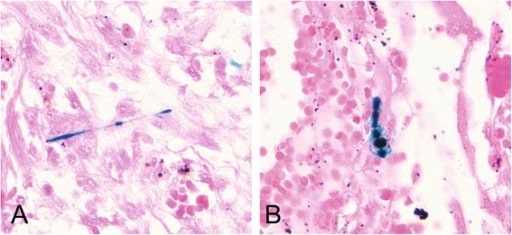Playlist
Show Playlist
Hide Playlist
Pneumoconiosis
-
Slides 06 ILD InterstitialLungDisease RespiratoryAdvanced.pdf
-
Download Lecture Overview
00:00 Another inhaled problem you can have causing interstitial lung disease are the pneumoconiosis. 00:06 Now, this is a non-allergic response to an inhaled substance, and tends to be dose response. 00:13 These substances tend to be those that you’re exposed to by your occupation or industry. 00:18 So it is a dust or a mineral exposure. The responses of fibrotic or an inflammatory response and the actual disease you develop depends on what substance you’re inhaling and the amount of it you’re inhaling so you get different patterns depending on these elements. 00:35 Recognition, again, does require a good occupational history, and not just the job that the patient is doing at the moment but also their previous occupations as well, because patients may present many years later after the exposure with lung disease due to previous occupation exposure. Now, probably the most important example of pneumoconiosis is asbestosis which is a pulmonary fibrosis that develops in people who have inhaled a lot of asbestos. Actually, clinically, it is identical to pulmonary fibrosis and very difficult to distinguish but the history will have--the patient will have a history of significant asbestos exposure. 01:16 Asbestos exposure causes other damage to the lung such as pleural plaques, pleural thickening and effusions and an unusual form of pleural cancer called mesothelioma, as well as increases your risk of lung cancer. The other major occupational problem is coal dust exposure, which causes a COPD pattern, a chronic obstructive pulmonary disease. 01:36 But also on the X-ray, you can see micronodular infiltrates, and occasionally, this coal dust to form what we call progressive massive fibrosis with a destructive fibrotic disease affecting the upper lobes of both lungs. And there are many other types of dust inhaled minerals that can cause lung disease of different patterns. For example, silicosis can also cause micronodular infiltrates and progressive massive fibrosis just like coal dust. Even inhaled beryllium, you may end up with disease which is relatively similar to sarcoidosis. 02:09 Again, treatment for pneumoconiosis is to remove the patient from exposure to that inhaled dust or mineral. Otherwise, actually, treatment options are limited. Medications do not seem to help. Importantly, patients with significant lung damage due to their occupation inhaling dust and minerals are generally entitled to financial compensation, and that’s a very important thing for the patient to explore as they may make their ability to cope with their disability much better with a little bit of financial help.
About the Lecture
The lecture Pneumoconiosis by Jeremy Brown, PhD, MRCP(UK), MBBS is from the course Interstitial Lung Disease (ILD).
Included Quiz Questions
Which of the following statements is FALSE regarding pneumoconiosis?
- Pneumoconiosis is an allergic reaction to an inhaled substance.
- Pneumoconiosis reaction is partially dose-dependent.
- Present and previous occupational history are important to elicit in patients with pneumoconiosis.
- Pulmonary findings of pneumoconiosis include fibrotic and inflammatory changes.
- Pneumoconiosis can occur due to industrial exposure.
Which type of cancer is associated with chronic asbestos exposure?
- Mesothelioma
- Adenocarcinoma
- Fibrosarcoma
- Leukemia
- Lymphoma
Which of the following diseases is associated with silicosis?
- Tuberculosis
- Sarcoidosis
- Aspergillosis
- Hemosiderosis
- Anthracosis
A patient presents with new-onset dyspnea. The patient was in the alloy industry for 30 years. Which of the following diseases must the patient be worked up for?
- Berryliosis
- Tuberculosis
- Asbestosis
- Sarcoidosis
- Anthracosis
Customer reviews
5,0 of 5 stars
| 5 Stars |
|
5 |
| 4 Stars |
|
0 |
| 3 Stars |
|
0 |
| 2 Stars |
|
0 |
| 1 Star |
|
0 |




